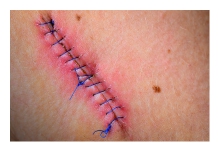 Surgical site infections (SSI) increase medical costs, length of hospital stays, and readmission rates. Although this rate may be under-reported, the incidence of SSI in the US is estimated to be 2.8%. In the inpt setting or generally?
Surgical site infections (SSI) increase medical costs, length of hospital stays, and readmission rates. Although this rate may be under-reported, the incidence of SSI in the US is estimated to be 2.8%. In the inpt setting or generally?
There are many factors involved in the development of an SSI. Bacterial factors include the inoculum size. Bacterial load at the site of infection of greater than 105 is considered to be indicative of infection rather than colonization. Virulence characteristics, resistance characteristics, and enzymatic activity also play a large role in the development of superficial surgical site infection. (superficial vs deep?)
Patient factors that increase the risk of SSI include age, nutritional status, significant weight loss within 6 months of surgery, immunosuppression, comorbidities (especially obesity, DM, and peripheral artery disease), and post-operative anemia. Each of these factors has been shown to play a significant role in increased risk for an SSI.
Surgical characteristics can also increase the chance of developing an SSI. Poor surgical technique, operative procedure length >2Hr, operative field contamination, and poor skin preparation/shaving have all been shown to increase the risk of an SSI. The American College of Surgeons (ACS) has classified surgical cases based on infective risk.
- Class I (Clean) Operative field is uninfected, there is no inflammation, no hollow viscera are entered, and the respiratory, GI, reproductive/GU are not breached. There are no major breaks in sterile technique. Operative incisions after blunt trauma where the respiratory, GI or GI/GU tracts are not injured also fall into this category. Infective Risk is
- Class II (Clean Contaminated) Operative field is uninfected, there is no inflammation, but the respiratory, GI, reproductive/GU tracts are breached but in a controlled manner as part of the operative plan, and without excessive or unusual contamination. There are no major breaks in sterile technique. Infective risk is < 10%
- Class III (Contaminated) Recent open (traumatic) wound, traumatic wounds older than 12 hours, surgeries or procedures with major breaks in sterile technique or major spillage from the GI tract, or incision into actively inflamed tissue (without purulence). Infective risk is 15-20%
- Class IV (Dirty/Infected) A wound where the organism causing the post-operative infection was present in the operative field before the procedure. There is an uncontrolled entry into hollow viscera. Active inflammation, as well as gross purulence, can be seen. Infective risk is up to 40%
It is common practice to utilize dressings to cover a surgical incision that has been closed by primary intent (skin edges are reapproximated using sutures, staples, skin glue, or other means). It is a common belief that the benefit of a post-operative dressing is to control exudate and bleeding, protect the incision from external contamination, protect healing tissue, and prevent infection of the incision.
However, a 2016 Cochrane Review does not support the use of a post-operative dressing, or any specific type of dressing, as a factor in preventing an SSI. The review included 29 articles (5718 subjects) published up to September 2016. While included studies were randomized and controlled, many were underpowered due to small sample sizes, varied surgical case types, and study bias and imprecision. As a result, the evidence quality was graded as low or very low for many of the studies. The authors could not find sufficient evidence that covering a surgical incision with any dressing reduced the risk of an SSI. They also could not support any specific type of dressing as reducing the risk of an SSI.
Due to the morbidity of SSI, interventions such as the Surgical Care Improvement Project (SCIP) have been instituted with the stated goal of reducing SSI. The use of a post-operative dressing is standard practice for most surgeons. While the postoperative dressing does control exudate and bleeding and provides a physical barrier while the incision epithelializes, further research is needed to determine if this practice is beneficial in the prevention of SSI.
References:
A Report from the NNIS System. Am J Infection Control. 1996 Oct 24(5):380-8.
Barie PS. Surgical Site Infections: Epidemiology and Prevention. Surg Infect. 2002; 3(Suppl) 1: S9-21.
Cruse PJ, Foord R. The epidemiology of wound infection. Surg Clin N Am. 1980 Feb 60(1):27-40.
Dumville J, Gray TA et al. Dressings for the prevention of surgical site infection. Cochrane Systematic Review. 20 December 2016.
Malone DL, Genuit T et al. Surgical site infections; Reanalysis of Risk Factors. J Surg Res. 2002; 103(1): 89-95.
Rosenberger L, Politano A et al. The Surgical Care Improvement Project and Prevention of Post Operative Infection, Including Surgical Site infection. Surg Infect. 2011 June; 12(3)L 163-168.


